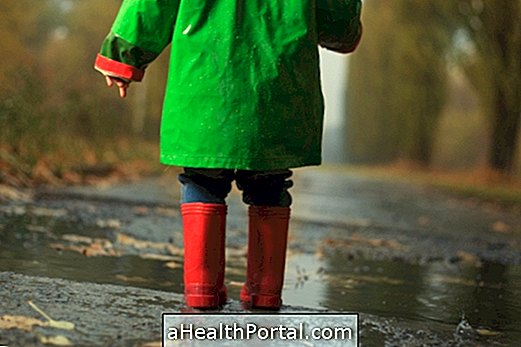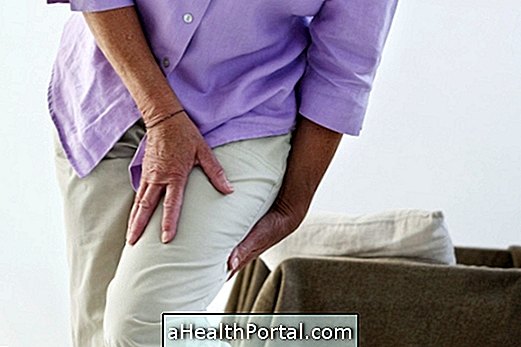When the knee is swollen it is advised to rest the affected leg and apply a cold compress in the first 48 hours to reduce swelling. However, if pain and swelling persist for more than 2 days, it is recommended to consult an orthopedist to diagnose the problem and initiate appropriate treatment.
In case of a swollen knee, what can be done to treat the problem at home includes:
- Maintain rest by supporting leg on a higher surface;
- Apply a cold compress in the first 48 hours to reduce swelling;
- Apply a warm compress from 48 hours to relieve muscle pain;
- Take anti-inflammatory and analgesic medicines such as Paracetamol or Ibuprofen every 8 hours and under the guidance of a doctor.
However, if the pain and swelling remain for more than 7 days, it is advisable to consult an orthopedist, as it may be necessary to treat with physiotherapy, remove excess fluid from the knee with a needle or, in more severe cases, knee. Discover other cares in: How to treat a knee injury.
Watch the following video because using hot or cold compress:

Main causes of swollen knee
Swollen knee is a symptom that can affect individuals of all ages, especially in the event of accidents, falls or when practicing physical activity such as football, basketball or running. Thus, it is important to inform the doctor or physiotherapist of how the knee pain started, whether there was a fall in which position the knee was, or if there is any other associated disease.
Usually when the knee is swollen there is an increase in synovial fluid, which is a liquid that serves to maintain lubrication of this joint. Its normal concentration is approximately 3 ml, but in some cases it can reach 100 ml causing pain, swelling and discomfort in the knee. Some situations that can cause swelling in the knee are:
1. Direct trauma

After a fall or direct or indirect trauma to the knee, it can become swollen and painful, which usually indicates an acute traumatic sprain, sprain or trauma, which can happen when there is an inflammation in the synovial membrane that covers the inside of the joints. This situation occurs when the person falls to his knees and they become swollen during the night, it is most likely an acute traumatic synovitis, which may contain accumulation of blood inside the knee joint, which makes the knee sore and purple.
- How to treat: Placing an ice pack can relieve pain, but resting with the raised leg is also recommended and a trauma ointment, such as gelol or diclofenac, may be applied. Learn more on Knee Synovitis.
2. Arthrosis
Osteoarthritis can leave the knee apparently swollen due to the deformities that the disease causes, which makes the knee larger, wider and less plump than normal. This change is very common in the elderly, but can affect younger people, around 40 years of age.
- How to treat: Physiotherapy is recommended, with electronic devices for pain relief, joint manipulation techniques, stretching and strengthening exercises. Other measures that may help are modifications in daily life such as, lose weight, avoid making efforts, prefer to wear sneakers or shoes very comfortable than walking in slippers or barefoot, for example. Check out the best exercises for knee arthrosis.
3. Arthritis

Arthritis in the knee can be caused by a fall, being overweight, natural wear and tear of the joint or due to a change in the immune system, such as rheumatoid arthritis, which makes the knee swollen and sore. But there is still the possibility of a reactive arthritis, which causes swelling and pain in the knee due to other diseases such as gonorrhea in the genitals, intestinal infection by salmonella or parasites.
- What to do: It is recommended to tell the doctor if you have any other symptoms or are having any other illnesses, or are being treated. In case of arthritis is recommended the use of anti-inflammatory drugs prescribed by the doctor and physical therapy. In addition, changes in lifestyle are also recommended, where it is recommended to avoid physical efforts. The diet should also be rich in anti-inflammatory and poor in industrialized foods such as sausages and bacon. Check out examples of some great exercises for arthritis.
4. Knee infection
When the knee becomes swollen and red may be an inflammatory or infectious process in this joint.
- What to do: In this case, it is always advised to go to the doctor, especially if the knee is very hot, to become swollen for more than 7 days, the pain prevents the movement of the leg or other symptoms appear like fever above 38ºC.
5. Baker's cyst
Baker's cyst is a small lump that forms behind the knee, which may make it slightly swollen, with pain and stiffness common in the area, which worsen with knee extension movement and during physical activity.
- How to treat: Physiotherapy is recommended to combat pain and discomfort, but does not eliminate the cyst, although it may facilitate living with it. See what else you can do to treat Baker's cyst.
6. Ligament injury
A rupture of the anterior cruciate ligament happens suddenly, during a football game, for example. It is possible to hear a strong click at the moment of rupture, which helps in accurate diagnosis. The feeling that the knee is swollen or there are cracks is also common.
- What to do: You should go to the orthopedist because tests are needed to assess the level of ligament rupture, and to evaluate the possibility of physical therapy and / or surgery. See more in: Knee ligament injury.
7. Meniscus injury
The knee does not always get very swollen in case of a meniscal injury, but a small swelling on the side of the knee may suggest this injury. Other common symptoms are knee pain when walking, walking up and down stairs.
- What to do: An appointment with an orthopedist is indicated because examinations may be needed as a resonance to prove the injury. To treat it is indicated to do physiotherapy, and in some cases, surgery may be an option to definitely eliminate the pain.
8. Dislocation of the patella

A sudden fall or crash may displace the patella causing a dislocation or patellar fracture. In this case besides pain and swelling, it can be observed that the patella is displaced to the side.
- What to do: You should go to the emergency room to perform tests such as the x-ray to check the seriousness of the situation. The orthopedic surgeon may be able to reposition the patella with his hands, or in surgery. Putting a cold compress on the knee can relieve pain while waiting for the appointment. The following may be necessary to take anti-inflammatory drugs to reduce pain. If this pain persists after about 3 weeks, it is also recommended to do physiotherapy.
Pain and knee swelling in pregnancy
Already the swollen knee in pregnancy is normal and happens due to the natural swelling of the legs, due to the effect of hormones progesterone and estrogen, which cause dilation of the veins. The increase in the belly and the weight of the pregnant woman can also cause swelling in the legs due to the accumulation of liquid and the inflammation of the tissues of the knee.
What to do: Rest with your legs elevated, wear low and comfortable shoes, as a soft sneaker is recommended. In addition, it may be helpful to throw cold water jets on your knees with your legs elevated, on the edge of a pool, for example. It is not recommended to take medicines or pass ointments without the knowledge of the obstetrician.






















